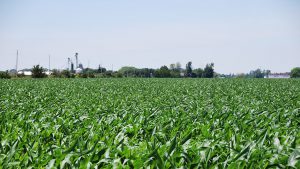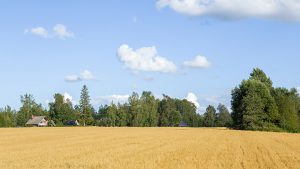Field observations
SPRING 2021
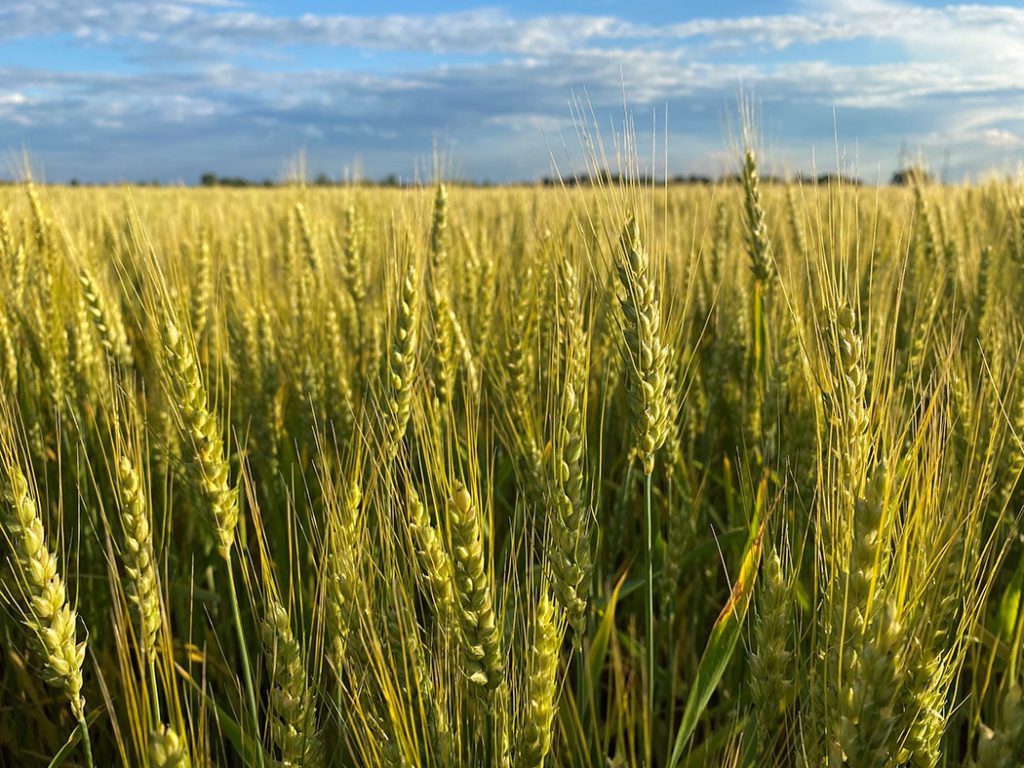
June 18, 2021
Select areas of Ontario have received spotty rains this past week which has caused some farmers to breathe a small sigh of relief, while other areas are still in need of a good rain. Scouting for insects, disease, weeds, and nutrient deficiencies are critical at this time to mange the crop for additional crop solutions if needed.
The corn crop is in the V5 to V8 stage (7 to 10 leaf stage), soybeans range from the unifoliate to the V2 to V5 stage (2 to 5 trifoliates) with reports that flowers have been spotted on the really early planted fields. Winter wheat is from GS69 (flowering complete) to GS83 (early dough). Winter barley is fast approaching full maturity with harvest expected to begin in the next two weeks.
Register for the #GrainTalk Farmer Forum here. CCA CEU credits are available.
Corn
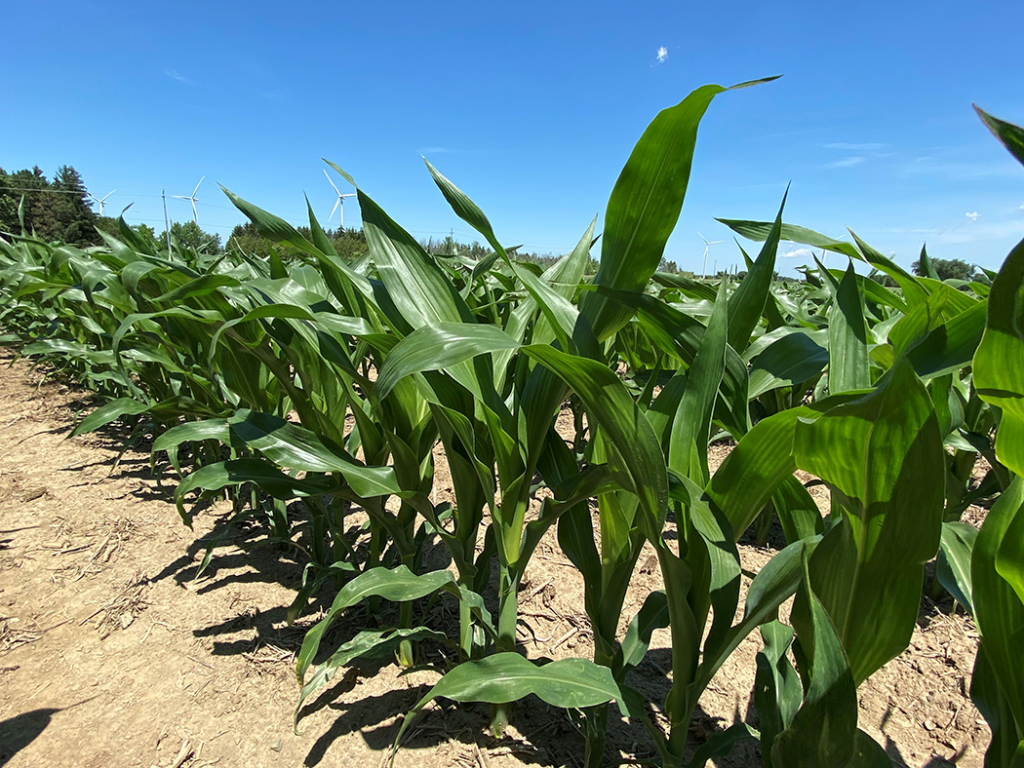
Overall, the corn crop is looking really good. Some areas have seen rapid growth syndrome caused by the transition from cool to warm temperatures, which causes the plant growth to speed up. Visually, the corn leaves do not unfurl properly and the whorl becomes twisted and wrapped.
The growing point is out of the ground and ear initiation is occurring currently. Any stress on the crop in the next two weeks will determine rows per ear and kernels per row as this is determined by V12 stage. Make sure your crop is well set up to be stress free at this time.
Be sure to scout for weeds. The impact of not getting rain and having weed escapes is active ingredient specific. Keep an eye on weed populations. Check for patterns in the field – did the sprayer miss or are you seeing resistant weeds? If a rescue treatment is applied, be sure to use a different active ingredient than the first pass. Some farmers may use glyphosate at a 2X rate, if the sprayer has overlap, those plants are now getting a 4X rate and flashing can occur which is when yellowing and chlorosis in the whorl is seen along with crinkled leaf edges. Surfactant burn can also occur which can cause some damage, at a higher rate of application in overlaps. There are many fields with a lot of weeds in them. Remember the critical weed free period in soybeans is V1 to V3 stage (1st to 3rd trifoliate), in corn it is V1 to V6 (1 to 6 leaf collars). Keep it clean early.
Tracey Baute, OMAFRA field crop entomologist, is looking for corn rootworm trap participants in Ontario. Those with continuous corn and with a history of repeated use of Bt-CRW hybrids are encouraged to participate, but fields that were corn last year and may be in other crops this year can also be scouted for emerging beetle populations. If you are interested in participating in the network and need traps and protocols, please contact Baute (tracey.baute@ontario.ca) so traps can be sent out before trapping starts at corn pollination timing.
Soybeans
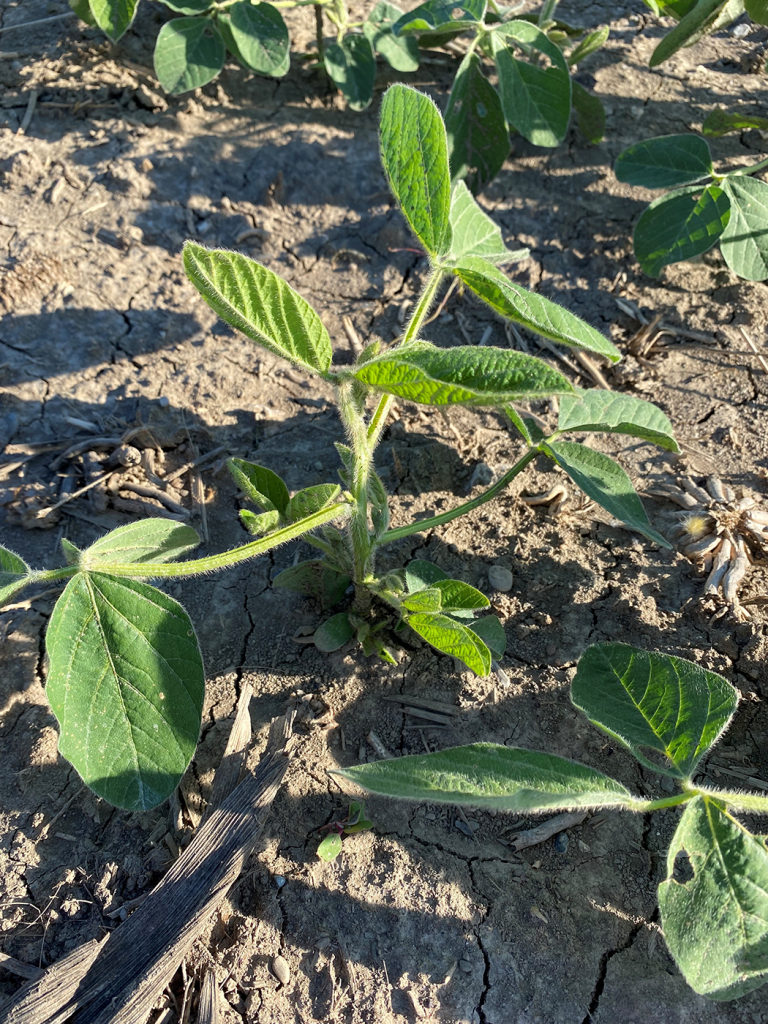
Soybean have really been progressing with some advanced to the 2nd to 5th trifoliate, with some field canopies almost closed. Expect to see some flowers next week as buds are forming on the most advanced plants. In some areas, soybean populations that had not emerged have received some rain and are now emerging, other areas are still waiting for rain.
There have been some reports of yellow beans in fields. This could be due to a number of reasons: herbicide burn, soybean cyst nematode, soil conditions being dry, the soybeans may be transitioning to nitrogen fixation, Mn deficiency (if you see this, apply Mn as soon as possible). Be sure to scout and see if there are patterns, on tops of knolly hills, etc to help determine the cause.
Around this time, soybeans should begin nodulating (five to six weeks after planting). It is always a good idea to see how nodulation is developing. Rhizobia in the soil infect the root and produce nodules on the plant where they fix nitrogen gas from the atmosphere turning it into a more useable form of nitrogen for the plant. In first time soybean fields, nodules will be found on the tap root; in fields that have had soybeans before, the nodules will be on the lateral roots. They should begin active nitrogen fixation around V2 to V3. The nodules should be quite large (two to four millimetres) and eight to 10 should be found per plant prior to flowering., If there are less, sample again in a week. Nodules that are actively working should be pinkish inside. If the nodules are small and whitish, they have not begun fixing nitrogen yet.
Some product inquiries have been heard of on fields that were sprayed with a herbicide during or right after the cold weather received a couple of weeks ago. During the cold, plants are not actively taking up herbicide, as the plant’s metabolism slows right down. If there is low plant biological activity, there will be reduced herbicide activity.
Cereals
This past week treated everyone to cooler day and nighttime temperatures, which is great for wheat that is in the grain fill period, as the wheat will have more days to fill as less growing degree days are accumulated each day. Many regions of Ontario have received rain this past week where they have not in the past, which can help with grain fill as well.
Cereal leaf beetle (CLB) has been spotted in winter wheat fields, with some spraying required. Fields are getting close to the pre-harvest intervals, always be sure to read and follow the label instructions. After CLB in winter wheat, it will move to spring cereals, so be sure to scout fields accordingly. If you are finding CLB in winter wheat, one CLB adult or larvae per stem is the guideline for control after boot but prior to heading. If lots of feeding is found on the flag leaf in early heading, control may be needed if they are feeding actively. If you are finding CLB in spring cereals, the threshold is an average of three larvae per tiller before the boot stage. View Page 345 of the Agronomy Guide to Field Crops for more info.
The Great Lakes YEN has been launched via a partnership between Grain Farmers of Ontario, Michigan State University, Michigan Wheat Program, Ontario Ministry of Agriculture, Food and Rural Affairs, and the University of Guelph. For more info visit https://greatlakesyen.com/. In the coming weeks, sponsorship opportunities for agricultural companies will be available for this ground-breaking program.
Cover crops
A series of free, practical webinars with experienced farmers and technical specialists presented by Soils at Guelph, Grain Farmers of Ontario, OMAFRA, and OSCIA are being offered. Certified Crop Advisor CEUs have been applied for.
All three webinars will run 12 p.m. – 1 p.m. Preregistration is required.
Part 1: Cover Crops and Manure, with Christine Brown, OMAFRA field crops sustainability specialist, Friday, June 25, Register here.
Part 2: Cover Crops for Weed Management with Mike Cowbrough, OMAFRA weed management-field crops, and Dr. Francois Tardif, University of Guelph, Tuesday, June 29 Register here.
Part 3: Cover Crops and Forages with Christine O’Reilly, OMAFRA forage and grazier specialist, Tuesday, July 6 Register here.
June 11, 2021
Crops have really taken off in some regions after a warm week with timely rains. Even though planting is finished there is still lots going on in fields with T3 applications in some areas, side dressing beginning in others, and post-emerge herbicides applications as well. Weed control will become the next big concern on farmers as some pre-emerge applications have let escapes come through; dry conditions limit perfect control. As crops are advancing quickly and crop canopies will be closing up in the coming week, farmers will need to be on top of their weed control timing in corn and soybeans.
Register for the #GrainTalk Farmer Forum here.
Corn
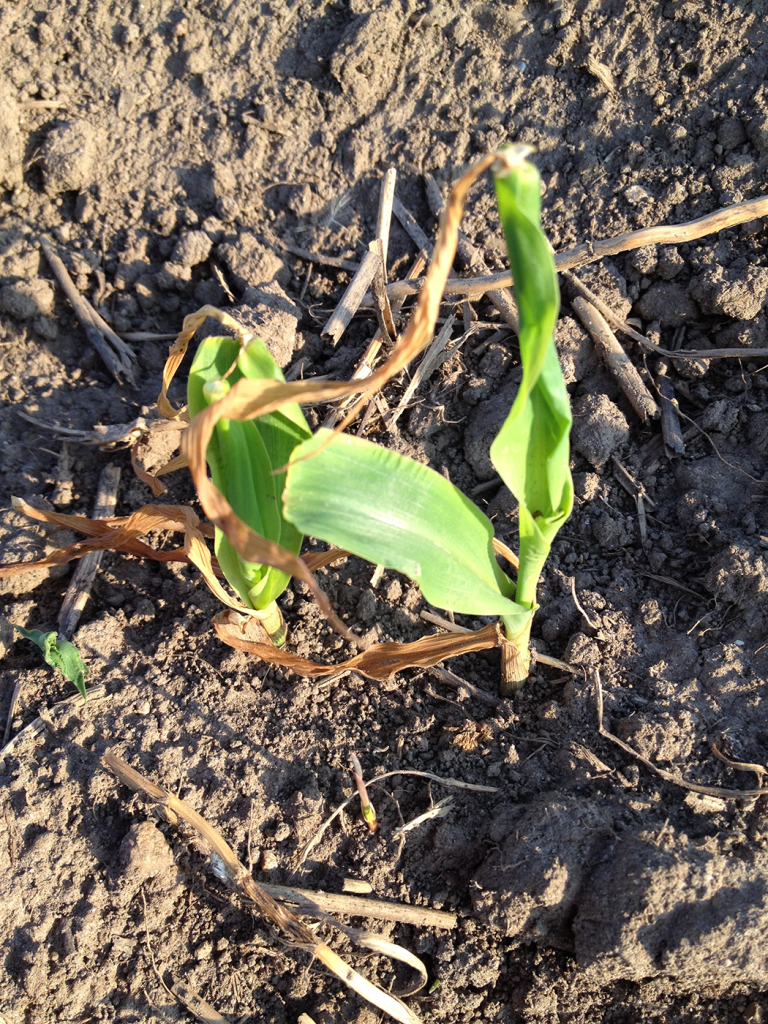
This past week’s heat has allowed for new growth on corn that was hit by the frost. Overall, corn is looking good, the frost damage is visible on the lower leaves, but two to three leaves have emerged above and are looking good. Many areas are seeing corn around the V4-V5 stage.
Some corn in southern Ontario is still showing purple from the cold stress, along with some corn looking like a “buggy whip.” This can be due to misapplied herbicides, or in this case, it occurs when conditions favor rapid growth after a period of slow growth, so with the cold weather experienced almost two weeks ago followed with very warm weather, this might be a common phenomenon in the field.
Side dress timing is here. The Ontario Ministry of Agriculture, Food and Rural Affairs (OMAFRA) has once again completed their PSNT test which measures the nitrate mineralized from the soil as an indication of year-to-year soil nitrogen supply. Grain Farmers of Ontario supports this initiative and results can be found here.
Tracey Baute, OMAFRA Field Crop Entomologist, is looking for corn rootworm trap participants in Ontario. Those with continuous corn and with a history of repeated use of Bt-CRW hybrids are encouraged to participate, but fields that were corn last year and may be in other crops this year can also be scouted for emerging beetle populations. If you are interested in participating in the network and need traps and protocols please contact Tracey (tracey.baute@ontario.ca) so traps can be sent out before trapping starts at corn pollination timing.
Corn Rootworm Trap Network Objectives:
- increase scouting efforts in continuous corn fields;
- understand changes in adult rootworm populations between years;
- raise awareness about changes in western and northern corn rootworm distribution and activity; and
- identify high risk fields needing additional resistance monitoring efforts.
This adult monitoring program is not meant to be used to determine if and when foliar applications on adults is required, nor is it to be used to determine if root protection is required in these fields in the following year. Further scouting is required in these fields to make those management decisions.
Soybeans
Some soybeans that were planted into dry soils and not into moisture are still waiting for rain to help with emergence. Some regions are reporting there are variable population stand counts; a nice rain would have solved a lot of these problems. Replanted soybeans are emerging if some moisture was in the soil or if they received a timely rain after planting.
With the change in weather this week, soybeans that stalled out last week at the unifoliate stage have jumped to the 2nd trifoliate and narrow row fields will be filling in fast over the next week.
Be sure to get out and scout your fields, weeds are certainly emerging, and you want to make sure that your pre-emerge herbicides have worked. Remember the critical weed-free period in soybeans is V1 to V3 stage (1st to 3rd trifoliate), in corn it is V1 to V6 (one to six leaf collars).
Some regions in the southwest are seeing aphids in early planted fields. For more on what to look for this early in the season, read here. The aphid advisor app is a great resource that Grain Farmers of Ontario helped support through research.
Wheat
Wheat in southwestern Ontario has hit the grain fill period. In other regions of Ontario, it is moving very quickly into heading and flowering. Do not miss the T3 timing, be sure to get out and scout for optimal timing. T3 sprays will protect against fusarium and rust if you have varieties that are prone to these diseases and if conditions are favourable.
Grain fill begins after pollination (Z70) and it takes about 660 growing degree days (GDD) for the grain to fill. The warmer the days, the faster the accumulation of GDD. And the shorter the grain fill period, the less potential that there is for yield. It would be nice if the grain fill period would see some rain along with temperatures being a little cooler, to extend the grain fill period.
Aphids in winter wheat have been found, it can be expected they will move to spring cereals and could see some barley yellow dwarf virus. More information can be found here, via the Crop Protection Network that Grain Farmers of Ontario supports.
If your field has a very lush canopy, you may have spotted powdery mildew in the springtime. It is still present in the field and is moving up the canopy. This disease likes lots of humidity and moisture, it doesn’t like rain as the rain will wash it off. With these humid days (you may have noticed the haze of moisture in the air) there is still lots of moisture in the canopy being found and therefore powdery mildew can also be found. Take a walk and see how your wheat crop looks for disease.
Some rust has been found in wheat, it is very varietal specific, many varieties have good resistance genetics but take a look and see if your wheat variety is one of the more susceptible varieties. Stripe rust moves very quickly in field compared to common leaf rust.
Other
As we look towards wheat harvest, if you used grain trailers, gravity wagons, and/or grain carts to move treated seed be sure to clean them out well. Contaminants in harvested grain can be cause for rejection of the load. Below are some suggestions from OABA on best practices for cleaning out.
- Thoroughly sweep and/or vacuum all surfaces and check all accessible areas for treated seed.
- Disassemble racks or tarps in order to examine where treated seed might have migrated and become trapped.
- Use compressed air to blow out any tubing pipe or angle irons.
- Pressure wash all surfaces.
- Let dry, and then drive down bumpy road with door closed. If treated seed is still present in wagon, identify where it originated from and clean that area.
- Clean up and discard all remaining treated seed and residues.
The Canadian Drought Monitor confirms again what many of us were aware of; it is dry. Many of the growing regions of Ontario are classified as abnormally dry to moderate drought.
June 4, 2021
THIS PAST WEEK has brought many ups and downs across the province. While some areas were lucky to receive some rain others were impacted by late season snow, freezing rain and sadly, frost over the past weekend. Where the soybeans were dead replanting has been occurring. The corn crop is being monitored for regrowth as it is trying to over come the frost damage. Some spring cereals were also damaged but waiting to see the full impact in the coming weeks. Register for the #GrainTALK Farmer Forum here.
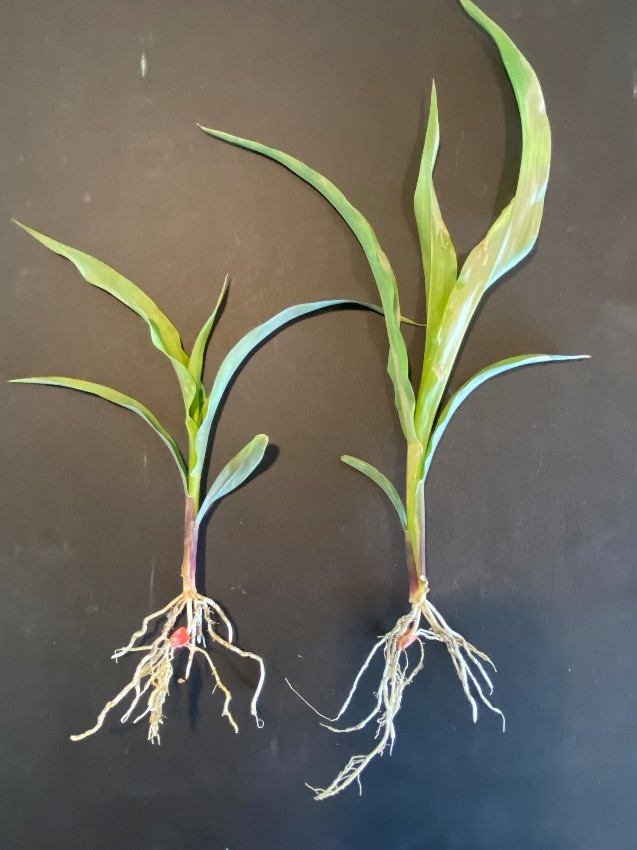
Corn
Learn more about frost damage, identification and what to expect here. For corn that has had leaves frosted off, the leaf stage is still the same whether the leaf is dead or alive. For proper growth staging on herbicide applications, make sure all leaves are counted.
Currently corn is undergoing a crucial stage, up until now corn has been developing the seminal roots and now it is time for the nodal roots to establish, roughly around V2 to V6 (2 to 6 leaf collars visible). By around V2 the first set of nodal roots should be visible, as each new leaf collar emerges, so will a set of nodal roots. Seedlings use nutrition from the seed reserves up until the V3 stage when they begin gathering nutrition from the nodal roots. If the nodal roots are damaged or stressed it can delay the corn’s development, due to the plant needing to rely on seed reserves as opposed to uptaking nutrients through the nodal roots. Things that might cause stress to the young corn plant’s nodal root development are salt injury from fertilizer, herbicide injury, seedling disease, insect feeding, compaction, and very wet or dry soils. Nodal roots will tap into the starter fertilizer band and use that nutrition for optimum development.

Some farmers might notice some purpling of corn plants in fields at this time. As with most things there is an environment by genetic interaction, meaning some corn hybrid genetics will show more purple than others. This is due to the genes in some corn hybrids for producing anthocyanin pigments. Under early season stress conditions and poor root growth, like our recent cold snap/frost with sunny days the plant builds and expresses the purple (anthocyanin) pigments. Purple corn can also be caused by phosphorus deficiencies from restricted root growth due to soil compaction like sidewall compaction in the seed trench from planting in wetter soils. Corn usually will grow out of the purple state if it has enough available soil phosphate, once the weather warms up and growth resumes. Typically no yield loss will be seen, if nutrients have been applied at proper levels.
Soybeans
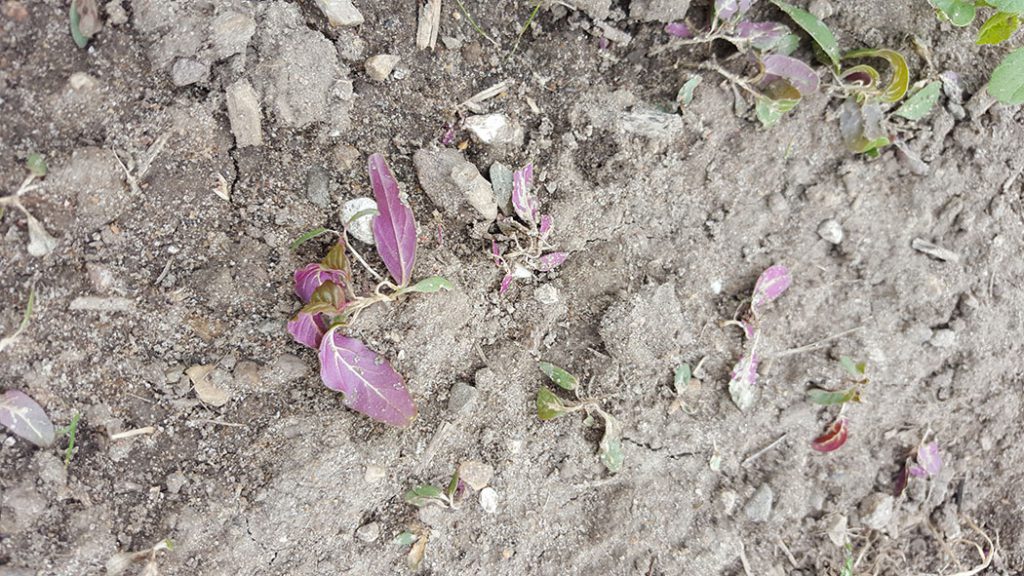
Soybeans have certainly caused some headaches this past week in regions across Ontario. Some soybeans have been touched by frost and others have been completely killed. Fields with the growing point killed or the entire plant has gone to mush are being replanted very quickly, as there was no chance of regrowth with the extreme cold temperatures getting down to -6oc at field level, and below freezing for over 8 hours. Some replanting conditions are extremely dry, which is a cause for concern, we hope rains in the forecast arrive to these dry regions. The soybean planting deadline extension for soybeans in the north has been extended to June 5. For more details, contact Agricorp at 1-888-247-4999. Insured clients must call/email Guelph directly to file a damage report.
For soybeans that are planted and actively growing, this dry weather is not the worst, as it encourages root growth while searching for moisture. It can also cause a lower chance for root disease and rots.
Be sure to scout your crops to look for weed escapes. There has been some residual pull back in areas that received some rain, but not all weeds and not all herbicide programs have experienced this so keep scouting.
Wheat
Winter wheat is steadily progressing across the province. In southwestern Ontario much of the wheat is fully headed out, and T3 fungicide applications have occurred over the past week or will be occurring once the field is at the right stage, GS 58-61. The main indicator for T3 timing is when 75 per cent of heads on the main stem are emerged (GS 59), this is Day 0, optimum timing is Day 2. This is the beginning of pollination when anthers are visible on the middle of the wheat head. A good reminder, make sure the sprayer is well cleaned out, as wheat is very sensitive at the flowering stage.
Ideal conditions for fusarium development is precipitation or high humidity for at least 12 hours for spore germination and infection. Temperatures favouring infection range from 16° C to 30° C, with the optimum range for F. graminearum being 25° C to 28° C.
Some leaf rust is appearing in wheat fields in southwestern Ontario. To learn more read Leaf Rust of Wheat. Grain Farmers of Ontario supports the Crop Protection Network. If you are wondering if your wheat variety is susceptible, visit the Ontario Cereal Crops Committee website. The lower the score, the higher the resistance. There have also been some reports of possible stripe rust in Ontario. The economic impact can vary depending on weather conditions that can accelerate the spread of rust. Be sure to scout your wheat to see how badly leaf rust and/or stripe rust are impacting your wheat fields.
If you are struggling with feeling overwhelmed with decisions, replanting, lack of rain etc and want to speak with someone there are many resources available.
May 28, 2021
A GREEN HUE is starting to emerge in Ontario fields as the corn and soybean crop is emerging. Forecasted rains will be welcome at this time, as shower activity to date has been sparse, and, in most situations, only enough to keep the dust down until the sun comes out.
Wheat is beginning to pollinate in southern Ontario while the rest of the province is in the boot stage. Rain is greatly needed across the province as the wheat will be getting into a critical grain fill period after pollination. As there are no moisture reserves left for the crop on the coarser soils, rain is needed quickly. Spring crops planted into dry soil will need some moisture to start the germination process.
Corn
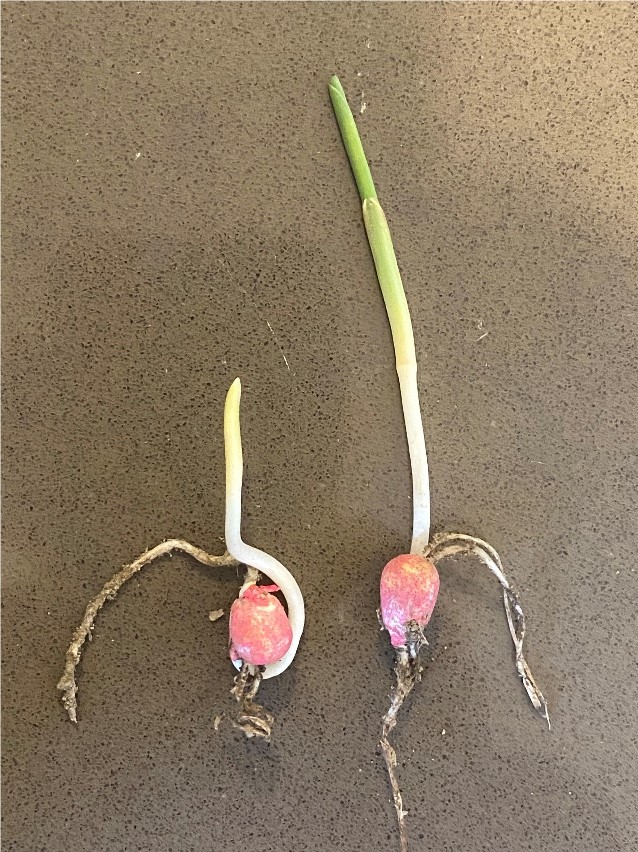
Corn emergence has been relatively good this spring with some uneven emergence reported on the earlier plantings. Some April planted corn had nine days without any heat accumulation and was paused in early May until the heat returned. This pause allowed time for cell damage to occur if conditions worsened, such as heavy rains firming the soil and the chilling effect weaking the vigour of the germinating seed, causing slow and strenuous emergence. Some of the slow emerging corn had leafed out underground as the coleoptile broke open and unfurrowed the first leaves, trapping the plant underground. Poor emergence could also be caused by other factors at planting time, mainly planter set up and adjustment. With variable soil conditions (which most fields have), down pressure settings, seed depth, closing wheel pressure, and type of closing wheels, combined with cold air and soils made for some uneven emergence. Sometimes we need to make a guess at the weather and adjust the planter for those future conditions. This year, if the seeds were too shallow, or packed too tight with the closing wheels, the seed would struggle to emerge.
Seed orientation also makes a difference in emergence and was found on both early and later planted fields. Unfortunately for the early planted corn, this difference was significant in delay and will affect the development and yield of the plant, while corn planted in warmer soils only had a 20 to 30 crop heat unit (CHU) delay resulting in only a slight delay. The coleoptile always emerges from the embryo in the direction opposite of the tip and grows toward the cap of the kernel. The tip is the part of the seed that attaches to the cob. If the seed is placed tip down, the coleoptile emerges and grows straight up to the surface. The kernel orientated with the tip up also has the coleoptile emerge at the tip end and grows along the side of the kernel to the cap (which is the downwards direction) until enough cell development occurs to turn the coleoptile in the opposite direction of gravity as it gets signals through gravitational force (geotropism) and redirects the shoot in the upright position so the plumula can emerge from the ground and establish a plant. This takes energy and time. Hopefully, one day, we will see planting technology develop a planter with the ability for tip down planting. If the seed is planted flat, then the shoot grows sideways and then turns to the surface, also a slight delay compared to the tip down placement, but not as bad as tip up planting.
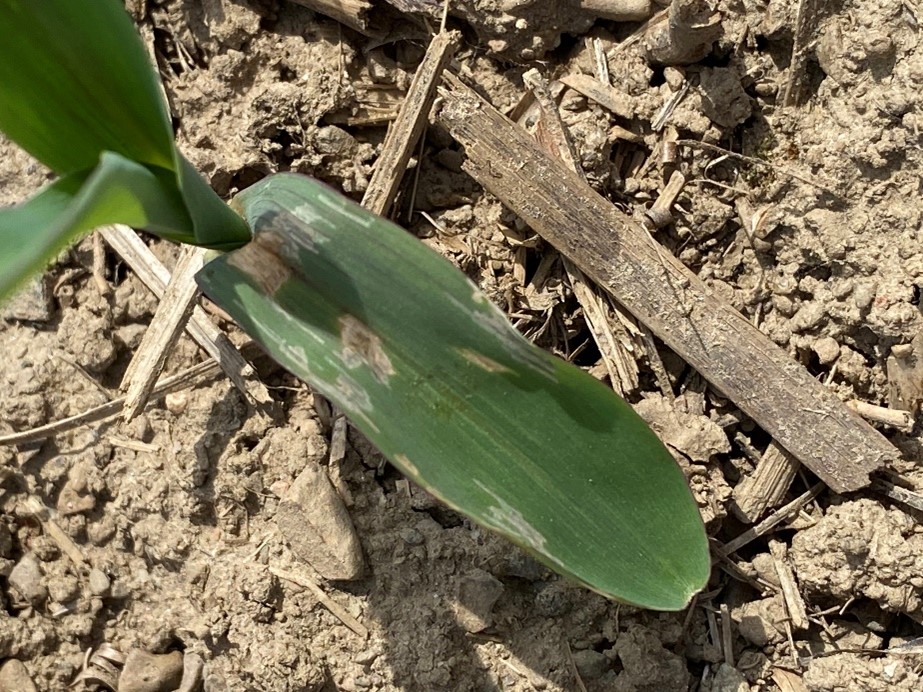
Corn development has moved fast this week with the heat. We are at the V2 (plant with two leaf collars) also called 3-4 leaf stage if you are counting leaf tips. Those that are side dressing nitrogen are getting ready to apply their side dress if little to no starter nitrogen (N) was used. As the crop is growing quickly, we do not want to allow the plant to get into a N deficiency too early in the season. The growing point of the corn will be emerging at V4 -V5, so 164 to 246 growing degree day (GDD) which will be eight to 10 days away.
Earlier planted corn has seen higher insect feeding in general as the seed has been in the ground longer and exposed to feeding longer. Seed treatments on corn has protected the seed well. The heat in mid-May, with drier conditions has been ideal for above ground insect development, watch fields for above ground insect damage as populations may expand under ideal dry conditions, currently populations are below threshold, but you will see some damage.
Soybeans
Planting is 90 to 95 per cent complete. Most soybeans are emerged as the bulk of the crop was planted over a week ago with ideal conditions for quick emergence when planted into moisture. This year has been the earliest completion of soybean planting in years, overall. There is still lots of time to plant soybeans in good time, if you are still planting.
If you are still wanting to plant soybeans. Planting at 2”- 2.25” should be no problem to get down to find moisture, even up to 2.5” is fine with nice, warm temperatures that have been experienced. Any deeper, and soybeans might not have the energy to reach the surface. Two questions to ask yourself prior to planting are: is the soil prone to crusting and does the variety have enough energy to push up to surface if looking at planting around the 2.5” or deeper. If you’re thinking of trying to plant into moisture but would be going into soil deeper than 2.25” it might be advisable to leave the seed in the bag until rain comes.
Soybeans once emerged can have poor stand establishment. They need to work hard to emerge and push the cotyledons out of the soil. If you experience some poor looking fields, you will need to do some stand counts and evaluate your stands for uniformity. As the season progresses depending on moisture, some replant decisions might be made.
The chart below can help guide you in deciding what your final stand count would provide for potential yield of your soybean crop.
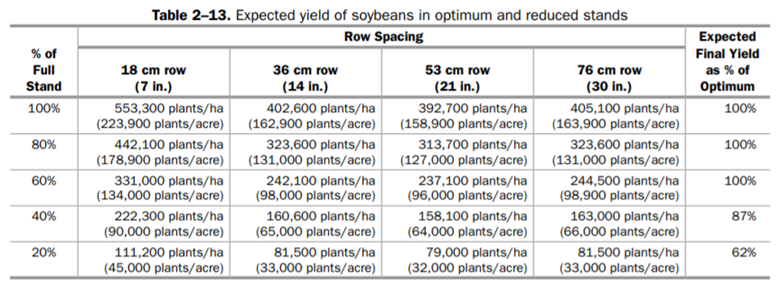
Keep an eye out for insect feeding damage on soybeans as insects are further ahead due to the warm weather early on, and soybeans are slightly more susceptible than corn for feeding damage.
The speed of soybeans emerging has caught people off guard for pre-emerge herbicide applications. Speak with your agronomist for other options if soybeans are close to emerging. A good rule of thumb after applying a pre- emerge is to set a calendar reminder for seven, 14, and 21 days after application to go and scout fields to see if the pre-emerge worked, or if a rescue treatment is needed.
There has been some concern on applying residual products that need rain to be activated. In some cases, once the rain does arrive there may be some reach back that will kill larger weeds – but this would only be true for weeds up to roughly the 2-leaf stage. Most annual weeds have not emerged yet in corn and soybeans, due to dry conditions, so it will be imperative once they do that, they are managed. Some weeds are hardening off which can create difficulties for herbicides to manage weeds such as lambs quarters etc, with this warm, dry weather. High winds have been impacting spray timing. Be sure to follow label recommendations for wind speeds when applying.
There are many herbicide trait options in the field this year; Roundup Ready, X-tend, Enlist, Liberty. Please be sure to apply the correct herbicide to the correct fields and ensure you ask your neighbour what trait they have instead of assuming everyone has the same as you. Try and avoid any disasters to yourself or your neighbours.
Soybeans should begin nodulating two to three weeks after emergence, it is always a good idea to see how nodulation is going. In first time soybean fields, nodules will be found on the tap root, in fields that have had soybeans before, the nodules will be on the lateral roots.
Wheat
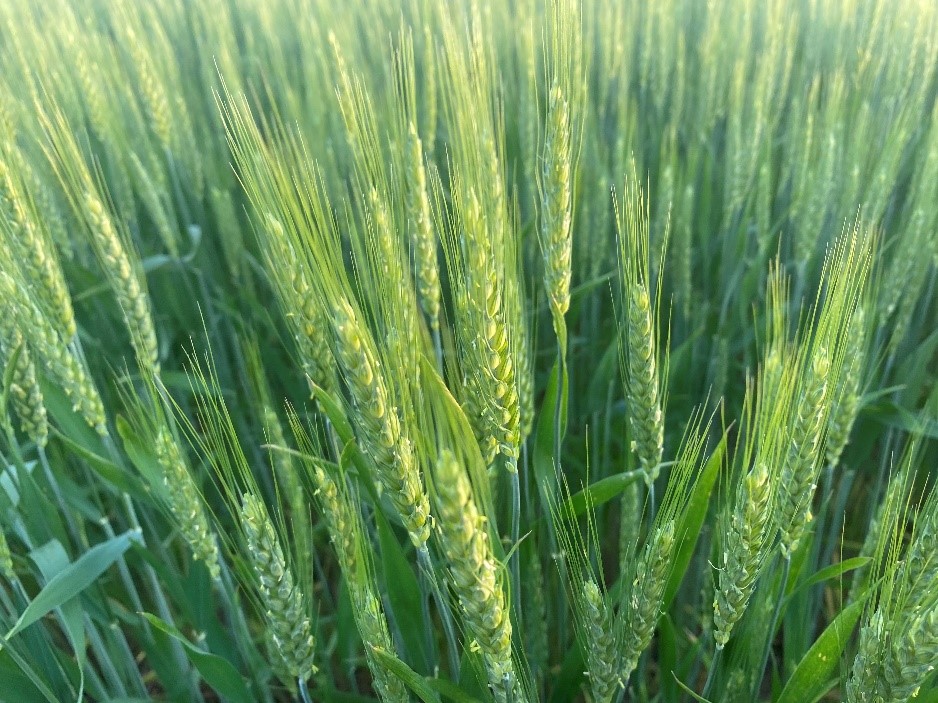
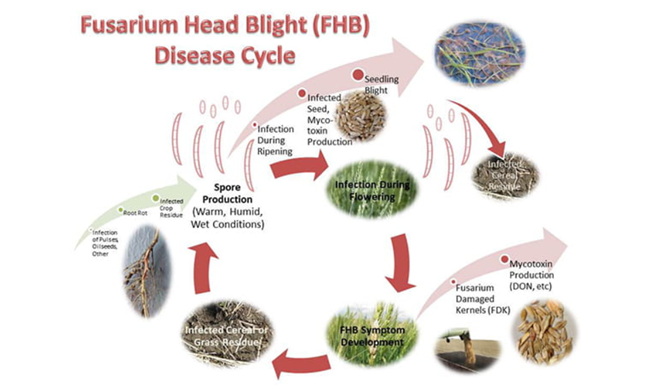
Wheat has rapidly moved through its growth stages in the past two weeks with the acceleration of heat accumulation. In southern Ontario, wheat is pollenating, further north wheat is in the flag leaf to boot stage (GS37-40).
T3 fungicide applications have been happening, GS 58-61. The main indicator for T3 timing is when 75 per cent of heads on the main stem are emerged (GS 59), this is Day 0, optimum timing is Day 2. This is the beginning of pollination when anthers are visible on the middle of the wheat head. A good reminder, make sure the sprayer is well cleaned out, as wheat is very sensitive at the flowering stage.
If no rain occurs during anthesis and early grain fill, the chance of DON is low. With no rain during grain fill, kernel grain fill will also be limited. Ideal conditions for fusarium development is precipitation or high humidity for at least 12 hours for spore germination and infection. Temperatures favouring infection range from 16° C to 30° C, with the optimum range for F. graminearum being 25° C to 28° C.
May 21, 2021
Well, that was quite a week of dry and warm weather. So dry, my humidistat showed 20 per cent relative humidity at one point and little to no dew. We also saw evening temperatures in the low 20s by the end of the week with daytime temperatures over 30° C. You could not program better planting weather if you wanted too. Now as planting has all but wrapped up on corn and soybeans, the speciality crops, such as vegetables and speciality beans that love warm soils, will have their turn at the planter. If the weather forecasters get it right, we may be in store for a few showers next week, which will be very welcomed on the farm as the wheat crop sure could use a drink. The spring planted crops in some areas also may need a little shot of moisture to help with germination if the seed bed was too dry.
Corn
With many corn acres in the ground in April, it is time to evaluate corn emergence. In some areas, there has been some irregular emergence with the early planted crop. As 50 per cent of the days since planting received below 10° C average daily temperature, troubles can occur. Poor seedling vigour or insect feeding can take population levels down. It is a good idea to evaluate it now and find out if it was insect, seed, or operator error. Corn that received 200 crop heat units (CHU) say on April 27, took 20 days to emerge. If planted this week with maximum CHU accumulation (30 per day) the corn could be out of the ground in five to six days, that is a lot less time for insects to be active, as well the soil temperatures would move them down in the soil profile as well. It is not time that gets the crop out of the ground, it is the heat that drives the enzymatic process to get the seed to germinate and the continued heat helps the cell growth of the developing plant seedling.
For best corn yields, we have been told from the U.S. corn specialists that if the crop emerges uniformly within a 12 growing degree day (GDD) (~20 crop heat unit (CHU)) window, you will be able to maximize the crop by having a picket fence stand. A great way to evaluate your emergence timing is to use the flag method – planting flags beside the plant as it emerges. Start by measuring 1/1,000 of an acre, that way you are also doing a population count at the same time. Then on the first day that you can see corn spiking through the ground, place a pin flag / tile flag beside all the emerged plants. Come back in 20 CHUs (or as in this past week it was every day) and place a different colour flag beside the newly emerged spike for that day. Keep doing this until all the corn is emerged. Be sure to use a different colour flag on different days (or label each flag with emergence date). Also, do the flag test on each row of the planter. If you find poorer emergence or delayed emergence on a particular row, it may be related to planter set up issues. This test is also great to evaluate different settings on the planter (deeper or shallower) or different attachments. Visually the row emergence may look the same, but once you start counting the plants in 1/1,000 of a row, you will be surprised at what you learn.
As the season progresses, pay particular attention to your flagged corn plot. See if the later emerged plants are weaker and smaller. Did they pollinate later? How was the ear size or cob fill? Does emergence timing make a difference on your crop?
Soybeans
April planted soybeans are beginning to emerge. It has taken the earlier plantings a while to emerge due to the cold soil temperatures. This past week’s warmth and days of up to 30 CHUs will really speed emergence along. If soybean planting is ongoing and in dry conditions, it is important to plant into moisture. The ideal planting depth for soybeans is around 1.5” to 1.75” with adequate soil moisture. If soil is drying out, or seed bed uneven, seeds may need to be planted around the 2”- 2.25” if on lighter soils, but only if moisture is limited. Remember, soybean hypocotyl reach is limited and can only extend that two plus inches. If conditions like crusting occur, than deep planted soybeans will not be able to push and extend the distance. Loose, dry soil may be the exception for the 2” plus depth. There is still lots of time to plant soybeans, so some growers may choose to wait until seed bed receives some rain and then plant when conditions are better.
With dry conditions in Northern Ontario, grasshoppers could be an issue again in the June timeframe. Soybeans are very susceptible as the grasshoppers clip the plant right at the bottom.
Wheat
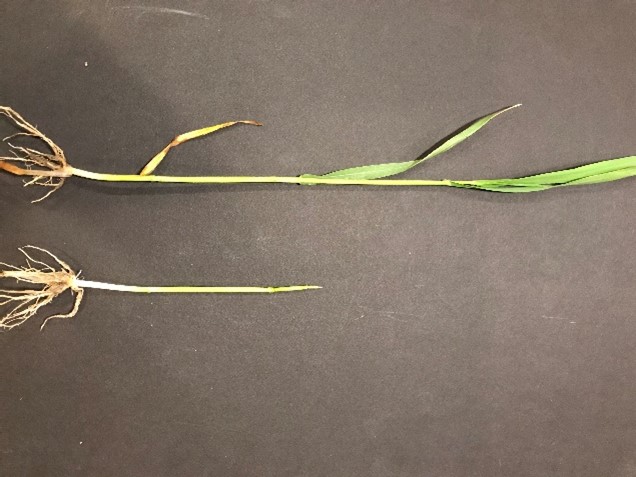
Wheat is at boot stage in southern Ontario (GS45) while in other parts of the province much of the wheat is in the full flag leaf. In Northern Ontario, the growth stage is in stem elongation (GS32-33). In the deep southwest, wheat is heading out next week, with farmers getting ready to spray for fusarium. Wheat fields that are most susceptible to fusarium infections are those planted after corn, or if a susceptible variety was planted. Once 75 per cent of the heads are completely emerged on the main stem (GS59) ideal fungicide timing is approaching. The optimum timing is at the beginning of pollination (GS61) when anthers are visible on the middle of the wheat head. Timing is critical, and the crop will be moving very quickly through stages with all this heat. Be sure that your sprayer has been cleaned out well prior to fungicide applications. Speak with our agronomist, or better yet, head out into the field (socially distancing) to check some wheat fields for staging.
Some wheat fields are showing fertilizer burn from applications around the cold weather. If flag leaf was not out at time of application, the damage would only be visible on the older leaf tissue and will cause little to no yield loss. With the heat and lack of rain this week, the wheat is moving fast through its growth stages and seems to be shorter at this time; rain the next week will help determine if straw length will extend, but consensus is the wheat will be short this year due to the higher temperatures we have received this week.
OMAFRA is leading a cereal leaf beetle survey with hopes to validate GDD models. The survey can easily be taken via your phone or computer.
May 14, 2021
The weather has turned the corner this week from spotty rains, cool temperatures, and light frosts to where we are now experiencing drier, warmer conditions that are hastening planting progress across the province. With the ideal forecast of sun and heat over the weekend and into next week, we will see the final touches of corn planting completed and the first crop of soybeans will be reaching planting completion into next week. Most acres should have the opportunity to be planted into ideal conditions as farmers will not be pushed by the concern of rainstorms, rather, seed may be looking for moisture and we will need to make sure seed beds are not in the position of being too dry.
Corn
Corn planted in early April has emerged, while later April plantings will be spiking through the ground this weekend. If you planned on a pre-emerge application, but are still in need of getting the herbicide applied, make sure no corn will be emerged by the time of spraying. Dig for seed to see how far the coleoptile is from the surface. If you have plants cracking the ground, change your application to early post emergence and make sure your herbicide program allows for application on emerged plants – some do, some do not. Pictured is corn planted on April 27, 2021 that has received 140 crop heat units (CHUs) since planting. Corn will be emerged within 40 more CHUs accumulated in the next day and a half.
If you are still planting corn, remember to plant into moisture and 2.5-to three-inch depth is ok if you need moisture. Also do not fluff the soil but keep the seedbed firm to retain the moisture.
Soybeans
Soybean planting has begun in earnest this week. As the weather holds favourably over the weekend and into next week we will experience rapid planting progress.
The increase in daytime and nighttime temperatures will drive CHU accumulation resulting in rapid plant growth (both weeds and crop). Burndown herbicide applications will now see faster acting herbicidal activity as plants are developing quicker as temperatures rise. Some weeds, such as winter annuals have continued to grow during the past few cool weeks. Canada fleabane has already progressed and is ready to bolt with these warmer temperatures. Be timely with your burndown as bigger weeds are harder to control and may need some additional measures to have effective control.
Double crop soybeans are a common conversation in some areas. Many are asking if double crop soybeans are an option this year following the early planted wheat last fall. With the last couple of weeks, wheat growth has really slowed down with the cool days and nights. The date of wheat harvest and the location in the province will determine a lot. Aim for seed maturity that is one full maturity group shorter than your area, but check with your seed dealer on what they suggest and what is available. Best success is with narrow row width and higher seeding rates as plant growth will be limited as plants will not branch and getting ground cover quickly is essential to maximizing yield. Target a population of 250,000 seeds per acre on 7.5” row width. The planting date should be considered as well as your average frost dates, as the yield potential will drop considerably if soybeans are planted too late and frost comes too early. Early to early-mid- July planting dates are the cut of for many areas. It is a risk, and those that have tried it in the past know that it all depends on moisture conditions or if the rains come in time to germinate the soybeans. Some years are great and some are a flop. If it does not work, consider it a good cover crop
The need for weed control in double crop soybeans will be less, as in theory one pass would still be needed to control weeds. Most annual weeds emerge during May and June. If double crop soybeans are planted in July weed pressure should be considerably less, but is dependant on soil moisture and rainfall. Limit the investment in weed control and make sure to use row width and population to help control weed pressure as well.
Winter wheat
There has been little progress on spraying wheat due to the cooler conditions with night frosts limiting the ability to safely apply product. If spraying is being done in cool conditions, many have focused on only using one product in the tank to prevent wheat injury. Second applications of nitrogen have been applied especially where flag leaves are starting to emerge. Wheat that has been burnt by frost, nitrogen application, or herbicide/fungicide tank mixes are recovering – some fields don’t look very nice but yield impact should be fairly minimal. Burn from a fungicide/herbicide application can impact yield so use caution when applying in cold weather. Be sure to speak with your agronomist to find out which herbicides are easier on wheat if temperatures continue dipping towards zero.
Wheat in Ontario is around the second node (GS31-32) up to flag leaf emergence (GS37, flag leaf just visible). Wheat has moved quite slowly this past month with the cold temperatures. Even if it has been warmer, the nights have still been quite cold.
Cereal leaf beetle has been spotted in Simcoe County. The pest manager app is a wonderful source of information on all pests. It can be downloaded here. Grain Farmers of Ontario supports much of the research that is used in the app. It is applicable for pests, weeds, and disease and is updated regularly based on current research data.
May 7, 2021
Light scattered showers across the province have slowed down planting this week. Rains have been patchy allowing some areas to continue where others have been on hold. Where possible, corn and soybean planting has continued when the seed bed is fit. Estimates on planted acres range from five to 70 per cent complete for corn and 10 to 15 per cent complete for soybeans, but progress within regions is still highly variable.
Winter Wheat
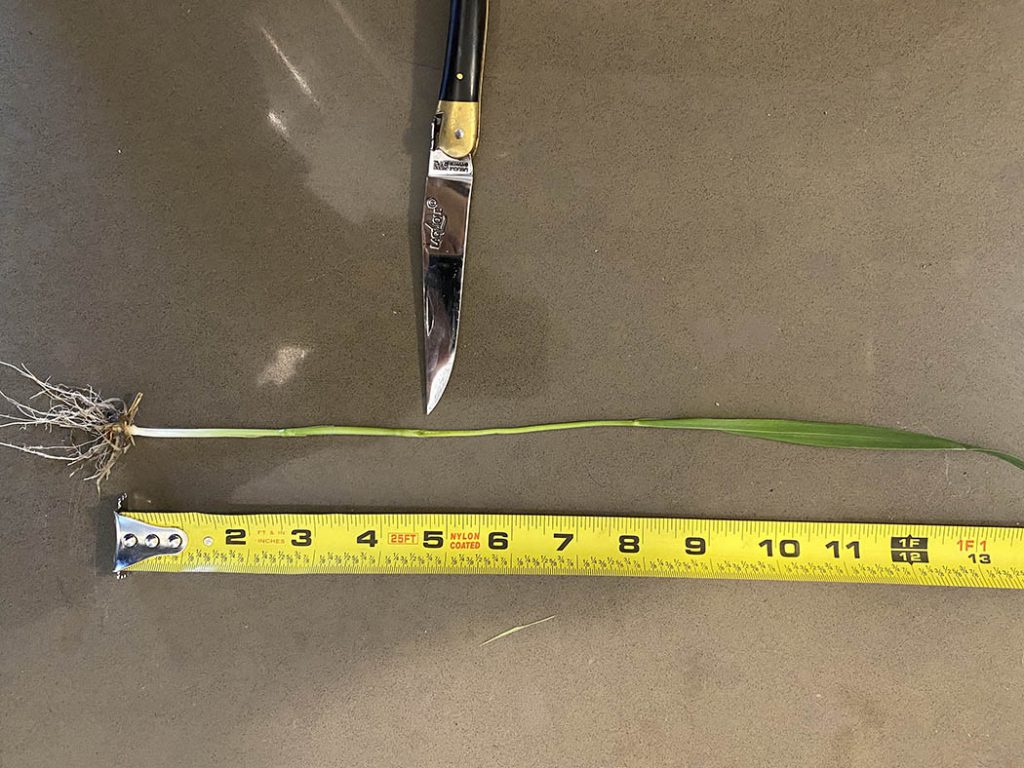
Wheat is progressing nicely, but with recent cold temperatures, growth has slowed down. Some fields that received snow a couple of weeks ago were flattened a bit but are slowly bouncing back.
If your area stays wet, be on the lookout for wheat diseases, there are still reports of powdery mildew and Septoria north and east of the London area. The rain received this week is favourable for stripe rust, it typically arrives on storm fronts and arrives in southwestern Ontario mid-May, although this year looking south at the spore source in the U.S. it is not looking like a huge threat at this point.
Flag leaf timing is getting close in those early planted fields in the deep southwest of Essex County. Herbicide applications need to cease by flag leaf as not to cause head injury.
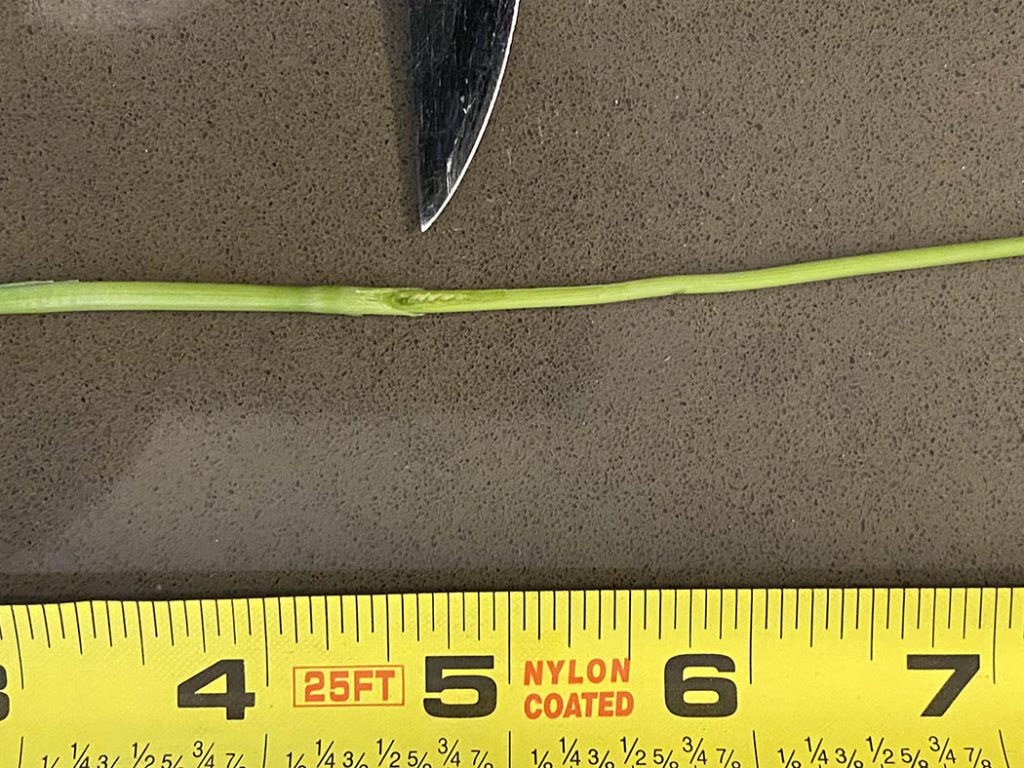
Corn and Soybeans
Some very significant acres have been planted for this early in the spring. There are still many to go, and patience is still key as it is still early for many areas to be planting. In the middle of May 2020, we saw ground that firmed up quite hard after planting as heavy rains and snowfall chilled the seed and firmed up the clay ground around them. As of now, we have not had that hard, pounding rain that causes the soil to become compacted. Current conditions of the seed that was planted seven days ago have had 100 crop heat units (CHUs) and look great. The radical is growing freely and is 1.5 inches long with the plumule starting to emerge from the seed. Emergence from the ground typically takes 180 CHUs. Warmer weather next week will allow much of the planted corn to emerge. Some really early April corn may already be emerging. In northern Ontario, corn is just beginning to be planted.
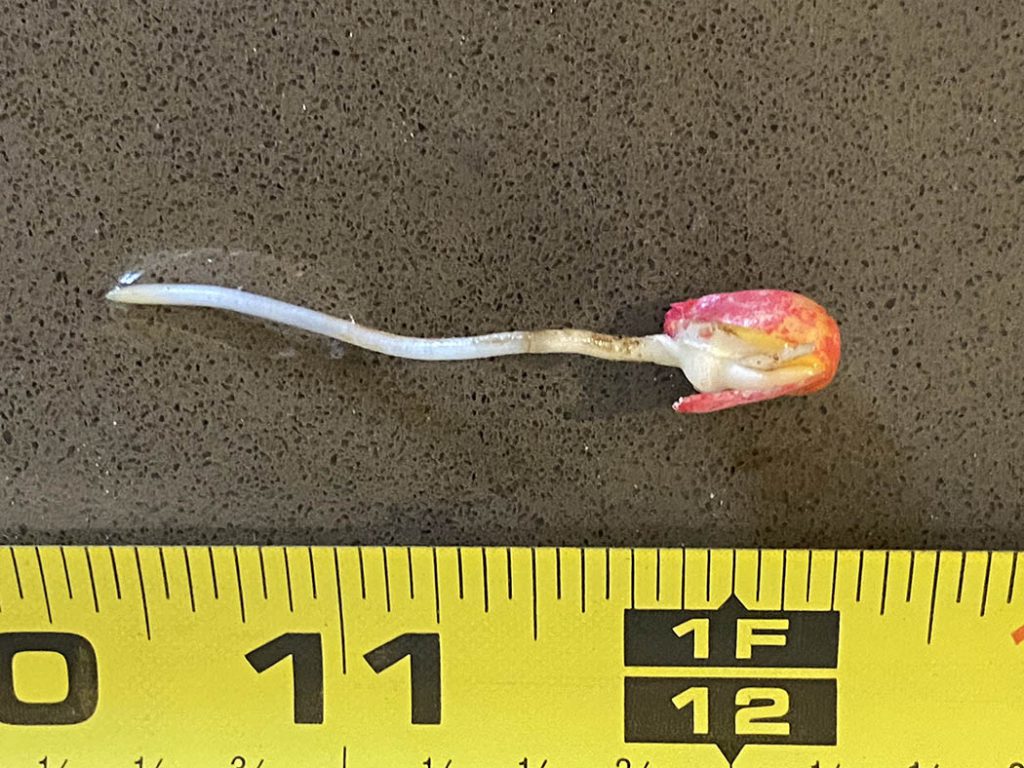
Black cutworm has been seen in some traps in Ontario. For more information on Black cutworm view this article from 2017 by Tracey Baute for damage description and thresholds.
For corn and soybeans that are planted already, the potential injury from soil applied herbicides goes up under cold conditions. In cold weather, the plant doesn’t grow as quickly, so it takes longer for the plant to metabolize the herbicide. Also, some herbicides create a layer on the soil surface, as plants emerge, cooler weather slows emergence through the herbicide layer allowing for longer exposure which may cause damage under cooler conditions. As temperatures increase, plants will grow more rapidly and will grow out of the injury and metabolize the product with no impact on yield. In general, we have seen warmer daytime temperatures than last year, but it still has been quite cool at night.
Next week is forecasted warmer and hopefully conditions open for the continuation of planting.
Other
Shortages on fertilizer have been minimal and manageable, mostly just due to the logistics of an early spring; shipments are on time for a normal year. If you are trying to identify weeds or send pictures of your plants for recommendations or guidance, taking a quality photo helps a lot. Doug Young at the University of Guelph Ridgetown Campus has created a short video on the best ways to photograph weeds and crops.
April 30, 2021
This week started out with some beautiful planting weather which contributed to a great start to the planting season. Some areas of the province had scattered showers that had some equipment shut down by mid to late week, while others were able to continue their planting progress.
Winter Wheat
The wheat crop looks good, with a large portion of the acreage having at least the first application of Nitrogen (N) on currently. Some fields that had an N application close to the frosts last week are showing some burn, but the wheat will grow out of it with limited impact on yield.
Timing for plant growth regulator (PGR) applications is upon us as most of the crop is at the 30 to 32 growth stage (starting stem elongation, first node). If you are mixing in a fungicide or herbicide with the PGR remember to watch temperatures and read labels to ensure you are using the appropriate tank mix partners. As with all spraying, ensure you have rinsed the tank and lines out well when changing to a new product in the sprayer, especially if putting down a corn herbicide or other non-wheat products that will damage the crop.
Some wheat in the Grey/Bruce area, which looked good in March, has been terminated due to snow mould impacts, cold injury and even wireworm in some cases.
Some wheat has been showing manganese deficiencies, predominantly in the sandy and loamy soils. There have also been some N deficiencies, Zinc deficiencies on clays, and some sulphur deficiencies as well. Be sure to get out and scout so you can take corrective action if needed.
Corn and Soybeans
Planting had a great jump this week as many corn and soybean planters were rolling. We are just at the beginning of May and have the entire month ahead of us. The first t wo weeks of May are considered the critical planting window that most farmers can expect to plant and achieve 100 per cent of their yield potential. This is a nice change compared to the last few years that saw many planting delays into June in some pockets.
When the ground has been fit to work, it has worked up well. With the lower soil moisture content that much of the province is experiencing, it is best to limit the depth of tillage and the number of passes as to conserve the moisture in the seed bed. The best seed beds are the stall seed beds that were prepared last fall or the ones where a light tillage pass has cracked the surface but left the seed bed at two inches firm and moist, just right for the seed to take in water and start the growing season.
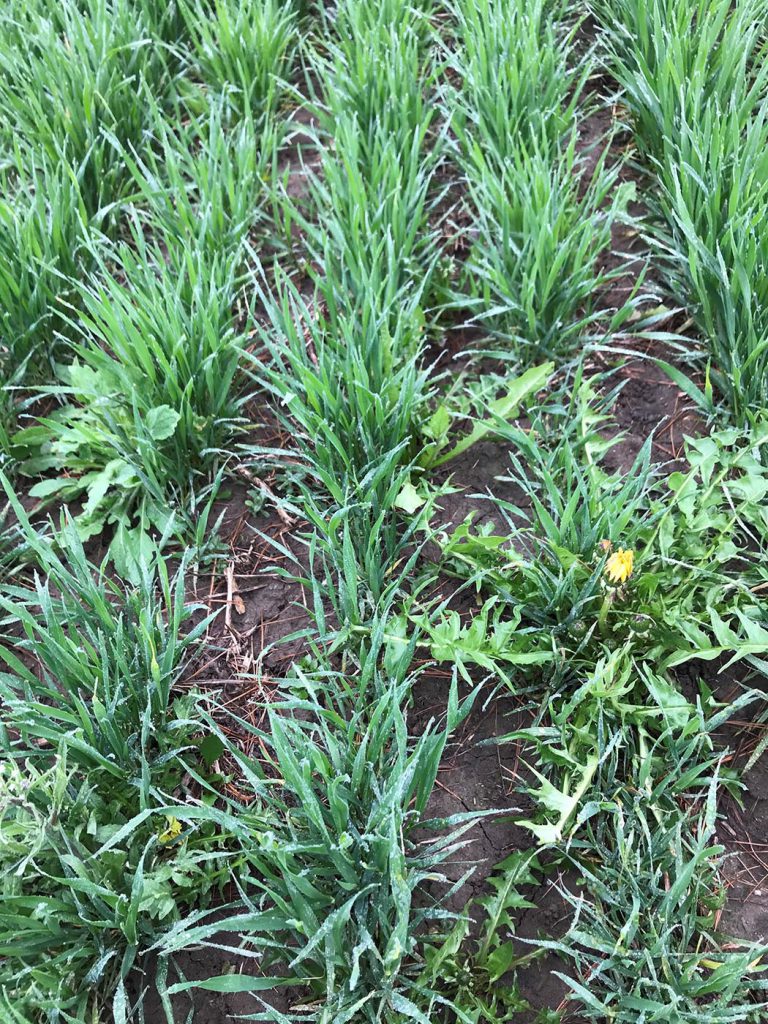
Lots of fertilizer and manure has been getting spread and ground getting worked. Remember the 4Rs when applying fertilizer- the right product, at the right rate, in the right place, and at the right time.
A few acres of soybeans have been planted, but most farmers will be focusing on corn right now. For soybeans that were planted early to mid April, most of them are just beginning to emerge.
Weeds
It has still been a bit cool and wet for some areas to begin spraying herbicides. In many areas, once annual weeds get further emerged, there will be some spraying of herbicides as the weather cooperates. Winter annuals are growing quickly. Watch that they do not get to a stage that they are too large to control easily, adjust rates to get good control.




















